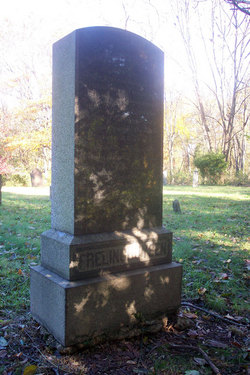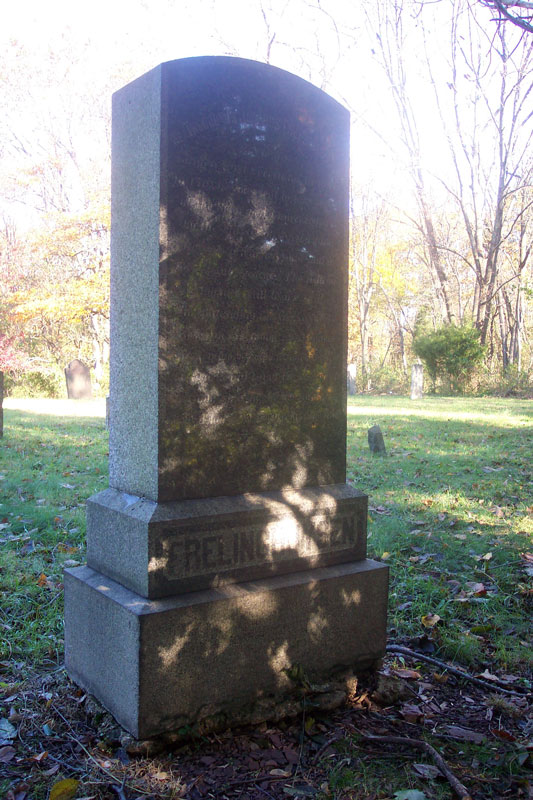Parents:
Son of Johannes Henrich Frelinghaus.
Birth:
He was born in Lingden, East Friesland, the Netherlands which is now part of Hanover, Germany.
Marriage:
He married Eva Terhune (1708-?).
Children:
He has the following children: Theodorus (Theodore) Frelinghuysen II, Reverend (1724-1761); Johannes (John) Frelinghuysen, Reverend (1727-1754) who married Dinah VanBerr; Jacobus (Jacob) Frelinghuysen (c1730-1753) who died at sea; Ferdinandus (Ferdinand) Frelinghuysen (c1732-1753) who died at sea, Henricus (Henry) Frelinghuysen (c1735-1757) who died in Ulster County, New York; Margaret Frelinghuysen (1737-1757) who married Thomas F. Romeyn, Reverend in 1756; and Anna Frelinghuysen (1738-1810) who married William Jackson, Reverend. All five sons became ministers and both daughters married ministers.
Migration:
Theodore is the immigrant ancestor for all the Frelinhuysens in New Jersey.
Biography:
The Encyclopedia of New Jersey states: "[He was] born in Lingen, Germany, the son of Johannes Henrich Frelinghaus, a pastor, Frelinghuysen matriculated at the University of Lingen and was ordained in Westphalia to the ministry of the Reformed Dutch Church in 1715, subsequently holding pastorates for a short interval in Belgium. In January, 1720, he and Jacobus Schuurman, a schoolmaster friend, immigrated to America, where Frelinghuysen served as minister to several Dutch Reformed churches in the Raritan Valley of central New Jersey until his death. Loyal to the Heidelberg Catechism, he emphasized pietism, conversion, repentance, strict moral standards, private devotions, excommunication, and church discipline. An eloquent preacher who published numerous sermons, he struggled against indifferentism and empty formalism. His theories conflicted with the orthodox views of Henry Boel and others, who challenged Frelinghuysen's religious emotionalism and unauthorized practices. As one of the fearless missionaries of the first Great Awakening in America, Frelinghuysen stressed tangible religious experiences. He trained young men for the clergy, often ordaining them without permission. His evangelical fervor and autonomous actions helped to instill an element of local independence for Dutch churches in North America's middle colonies. Frelinghuysen married Eva Terhune of Flatbush, Long Island, and fathered seven children. He died in Somerset County, New Jersey." His monument lies in the very back of the Elm Ridge Cemetery in its own row, trees grow directly behind it and the inscription faces the woods and cannot be read from the cemetery. This may be a cenotaph since his original burial location has been a mystery since he was interred without a marker. He is the oldest-born person in the cemetery and one of the earliest burials. He is the only person in the cemetery born in the 1600s. According to Dr. Francis Clark of New Brunswick the cemetery was facing the original Kings Highway, the current Route 27. When the highway was moved the land that was the old highway became the Hidden Lakes condominiums and now the oldest graves face the woods, and the condominiums that lie behind them.
Inscription:
Rev. Theodorus Jacobus Frelinghuysen. Born at Lingen, East Freesland in 1691. In 1719 he was sent to take charge of the Reformed Churches here by the Classis of Amsterdam. He was a learned man and a successful preacher. The field of his labor still bears fruit. In contending for a Spiritual Religion his motto was, "Landem non quero culpam non timeo." He died in 1747, and his descendants, humbly sharing in his faith, have erected to his memory this monument.
.
Parents:
Son of Johannes Henrich Frelinghaus.
Birth:
He was born in Lingden, East Friesland, the Netherlands which is now part of Hanover, Germany.
Marriage:
He married Eva Terhune (1708-?).
Children:
He has the following children: Theodorus (Theodore) Frelinghuysen II, Reverend (1724-1761); Johannes (John) Frelinghuysen, Reverend (1727-1754) who married Dinah VanBerr; Jacobus (Jacob) Frelinghuysen (c1730-1753) who died at sea; Ferdinandus (Ferdinand) Frelinghuysen (c1732-1753) who died at sea, Henricus (Henry) Frelinghuysen (c1735-1757) who died in Ulster County, New York; Margaret Frelinghuysen (1737-1757) who married Thomas F. Romeyn, Reverend in 1756; and Anna Frelinghuysen (1738-1810) who married William Jackson, Reverend. All five sons became ministers and both daughters married ministers.
Migration:
Theodore is the immigrant ancestor for all the Frelinhuysens in New Jersey.
Biography:
The Encyclopedia of New Jersey states: "[He was] born in Lingen, Germany, the son of Johannes Henrich Frelinghaus, a pastor, Frelinghuysen matriculated at the University of Lingen and was ordained in Westphalia to the ministry of the Reformed Dutch Church in 1715, subsequently holding pastorates for a short interval in Belgium. In January, 1720, he and Jacobus Schuurman, a schoolmaster friend, immigrated to America, where Frelinghuysen served as minister to several Dutch Reformed churches in the Raritan Valley of central New Jersey until his death. Loyal to the Heidelberg Catechism, he emphasized pietism, conversion, repentance, strict moral standards, private devotions, excommunication, and church discipline. An eloquent preacher who published numerous sermons, he struggled against indifferentism and empty formalism. His theories conflicted with the orthodox views of Henry Boel and others, who challenged Frelinghuysen's religious emotionalism and unauthorized practices. As one of the fearless missionaries of the first Great Awakening in America, Frelinghuysen stressed tangible religious experiences. He trained young men for the clergy, often ordaining them without permission. His evangelical fervor and autonomous actions helped to instill an element of local independence for Dutch churches in North America's middle colonies. Frelinghuysen married Eva Terhune of Flatbush, Long Island, and fathered seven children. He died in Somerset County, New Jersey." His monument lies in the very back of the Elm Ridge Cemetery in its own row, trees grow directly behind it and the inscription faces the woods and cannot be read from the cemetery. This may be a cenotaph since his original burial location has been a mystery since he was interred without a marker. He is the oldest-born person in the cemetery and one of the earliest burials. He is the only person in the cemetery born in the 1600s. According to Dr. Francis Clark of New Brunswick the cemetery was facing the original Kings Highway, the current Route 27. When the highway was moved the land that was the old highway became the Hidden Lakes condominiums and now the oldest graves face the woods, and the condominiums that lie behind them.
Inscription:
Rev. Theodorus Jacobus Frelinghuysen. Born at Lingen, East Freesland in 1691. In 1719 he was sent to take charge of the Reformed Churches here by the Classis of Amsterdam. He was a learned man and a successful preacher. The field of his labor still bears fruit. In contending for a Spiritual Religion his motto was, "Landem non quero culpam non timeo." He died in 1747, and his descendants, humbly sharing in his faith, have erected to his memory this monument.
.
Inscription
Rev. Theodorus Jacobus Frelinghuysen. Born at Lingen, East Freesland in 1691. In 1719 he was sent to take charge of the Reformed Churches here by the Classis of Amsterdam. He was a learned man and a successful preacher. The field of his labor still bears fruit. In contending for a Spiritual Religion his motto was, "Landem non quero culpam non timeo." He died in 1747, and his descendants, humbly sharing in his faith, have erected to his memory this monument.
Family Members
Advertisement
Explore more
Sponsored by Ancestry
Advertisement



